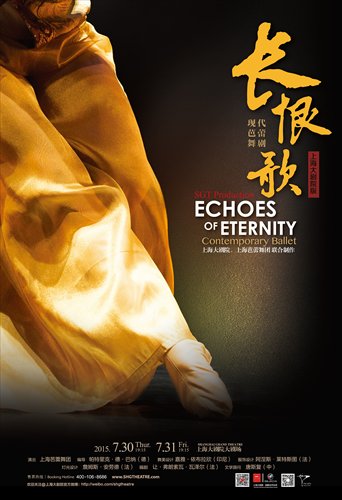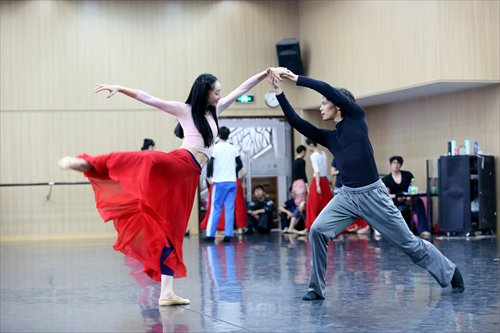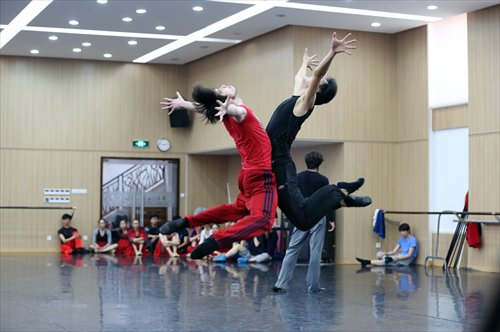Echoes, eternity and an emperor
Modern ballet revisits Tang Dynasty love story
When the German ballet dancer, choreographer and director Patrick de Bana came across an English edition of the Qing Dynasty (1644-1911) play The Palace of Eternal Youth in a bookstore in 2013, he was immediately enchanted by the love story between the Emperor Ming of the Tang Dynasty (618-907) and Lady Yang, one of the best-known pairs of lovers in Chinese history. That was just after De Bana had directed the acclaimed modern ballet Jane Eyre for the Shanghai Ballet and the Shanghai Grand Theater. That was how he decided his next project and it became Echoes of Eternity, De Bana's second directorial project with the Shanghai Ballet. It premieres at the Shanghai Grand Theater on July 30-31.

A poster for Echoes of Eternity
Zhang Xiaoding, the general manager of the Shanghai Grand Theater, believes modern ballet is the perfect form to reinterpret the very classic love story. "Looking back at a centuries-old, familiar story with a modern approach is more interesting and more relevant for viewers today," Zhang told the Global Times.
Crazy, sad, tormented
"If you want to make a ballet today, you need something more than just a love story - people don't believe this anymore, at least not so much," De Bana said during the rehearsals in mid-June. "I love creating crazy, sad, tormented love stories and letting people see things that they don't normally see."
To achieve the desired intensity, De Bana tried hard to give the dancers from Shanghai Ballet another way of expressing their emotions through their bodies. He admitted this was the biggest challenge of the entire project.
"People who do not care for pretty faces can do it much better," De Bana said. "I want a pure body to express happiness, sadness, drama and tragedy."
These emotions are manifested through a series of solos, pas de deux, pas de trois and corps dances. Alongside the five key roles of the original story - the Emperor, the Lady, the rebel An Lushan, the General Chen Xuanli and the eunuch Gao Lishi - De Bana has created a new character, the Moon Fairy from the Temple of the Moon. Unlike history and in the many artistic interpretations, in this retelling Lady Yang eventually returns "home" to the Temple of the Moon.

Lady Yang and Emperor Ming in a rehearsal
Not a Western interpretation
De Bana is not the least bit in favor of the concept that this ballet is a "Western interpretation of a Chinese story" as some writers have suggested. The idea of giving love a nationality and a passport, De Bana pointed out, is old-fashioned.
"It is a beautiful story that the whole world has the right to hear about and you don't need to be Chinese to feel the love and sadness in it," De Bana said.
Nor is there an expiry date for this story. "History always repeats itself and all I have to do is just open my eyes and look around me - look at the news, read books from today - and the same story of Emperor Ming and Lady Yang probably happens a hundred thousand times, perhaps in a village, perhaps in one of the beautiful films from Wong Kar-wai," De Bana said.
"So this work is not about Emperor Ming and Lady Yang but a Mr Ming and Miss Yang," De Bana said. "I've asked the dancers to think of it that way, too."

The rebel An Lushan and the General Chen Xuanli in a rehearsal
Photos: Courtesy of Shanghai Grand Theater
Novel set design
The director chose the noted Indonesian architect and interior designer Jaya Ibrahim as his set designer after he had dined in a hotel featuring the artist's exquisite, oriental designs. Sadly, in May, not long after Ibrahim had submitted a third design draft to the Shanghai Ballet, he passed away. The final design, which actually would have been Ibrahim's first ballet set design, was completed by his studio.
General manager Zhang said Ibrahim's design makes a perfect combination of the "substantial" - the components of palaces on stage - and the "symbolic," the gardens, skies, and clouds often seen on backdrops or in outlines that resemble classic water and ink paintings.
"The emphasis has been put on the 'symbolic' which gives more space for the dancers," Zhang said. "The design also helps break the confinements of one set and is more imagination-friendly."
The costume design for the show takes inpiration from clothing in the Tang Dynasty.
De Bana, who said he really enjoys dreaming about the past, hopes the choreography, dancers, set design and costumes will create a dream. "Maybe it is a dream which ends badly in a nightmare - but then, hopefully, the dream will come back and the nightmare will be over," he said.
Date: July 30 -31, 7:15 pm
Venue: Shanghai Grand Theater
上海大剧院
Address: 300 Renmin Avenue
人民大道300号
Tickets: 160 yuan to 680 yuan
Call 6217-2426 for more details